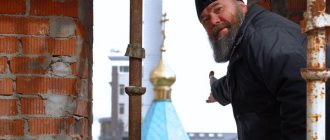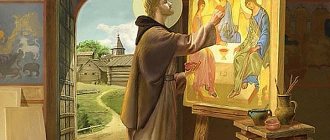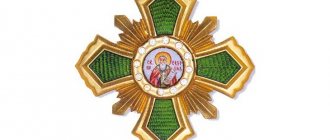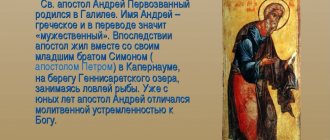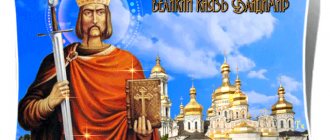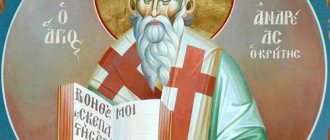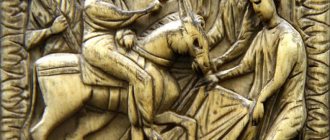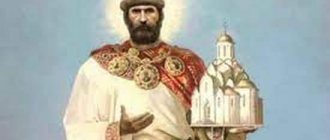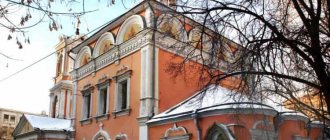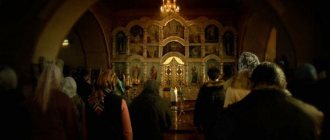THE LAST JUDGMENT (ANDREY RUBLEV)
Part 1: Icons
Part 2: Theophanes the Greek
Perhaps I’ll start this part with an excerpt from Andrei Tarkovsky’s film
Why was Andrei Rublev so tormented? Why didn’t he start painting the temple? After all, there were ancient examples - with the canonical painting of the western wall, and there were innovative works by Feofan. He could even see them with his own eyes, because both worked at the end of the 14th century in Moscow. If you watch Tarkovsky's film further, (https://www.youtube.com/watch?...) you will see pictures of the Last Judgment in the understanding of Andrei Rublev: The Last Judgment as the creation of a new world - a world of unity of Heaven and Earth, God and Man - Russian person! This idea of Sergius of Radonezh: to overcome, united, conciliarly
- gave Rus' victory on the Kulikovo field and led, through all adversity, to the Russian Renaissance of the 15th century.
Only twice the name of the Monk Andrei Rublev is mentioned in the chronicles. And both times it, among other names, comes last.
A simple monk, a monk who refused fame and recognition from the world, Andrei Rublev gained fame that other princes and rulers did not know. However, we know practically nothing about the man who left behind masterpieces of world significance. Legends, versions, hypotheses, assumptions - his biography is full of them. And even life does not give us practically any specific information. But one date, among all others, causes the least doubt: in 1408, Andrei Rublev came to Vladimir to paint the already famous Cathedral of the Assumption of the Virgin.
On July 17, the famous icon painter took monastic vows with the name Andrei - in honor of the Monk Andrew of Crete. And it was no coincidence that this name was chosen. Andrei Kritsky is the most profound poet of the early Middle Ages, who wrote the “Repentant Canon,” which was later called the great canon. And if Andrei Kritsky is an unsurpassed singer of repentance, then Andrei Rublev is a singer of love for man. The tranquility and humanity of Andrei Rublev’s creations shakes the soul. The master touched with his brush questions of the deepest morality.
The fresco “The Last Judgment” by St. Andrei Rublev, painted in the Vladimir Assumption Cathedral, is a national treasure of Russia, a unique work, listed as a UNESCO World Heritage Site. Before and after Rublev, as academician D. Likhachev notes, no one wrote like that.
General view of the central nave
Like Feofan, Andrei Rublev did not occupy the western wall, placing the composition under the arches of the choir balcony closer to the eyes of the worshipers. The Terrible Sou himself is in the central nave, Abraham’s bosom, paradise is at the right hand of Christ (it is these parts of the composition that have come down to us). On the left side, apparently, as required by tradition, the hellish torments of sinners were written (this part of the painting has not survived).
When you walk into the cathedral under the western arch, you see a circle above your head, in which is inscribed a huge half-clasped Hand of God, in which the Lord contains the souls of all the righteous. “ But the souls of the righteous are in the hand of God, and torment will not touch them
» book of Wisdom of Solomon
The souls of the righteous are in the hand of God
In the same arch he places King David (to the left of the Hand of God) and the prophet Isaiah (to the right of the Hand of God).
Arch with the Hand of God, David and Isaiah. General view of the painting of the Last Judgment on the vaults and in the arch on the left and right
In David's hand is a scroll with words addressed to those who do not fear God's judgment and walk in unrighteous ways, knowing about their atrocities. The king's face is meek and full of concern for them.
Prophet and King David in the arch
The fresco of the prophet Isaiah has not been completely preserved, only his robes and a scroll with words addressed to the stiff-necked Jewish people, whose eyes are blinded, whose ears do not hear, and cannot see the truth, remain.
Below the images of the prophets are depicted archangels with trumpets announcing the resurrection of the dead for the Last Judgment. Under the image of the prophet Isaiah - Archangel Gabriel
with a pipe raised up;
on the contrary, under King David, with a trumpet lowered to the ground, is the Archangel Michael
.
Their trumpet voice is directed in the direction where the Earth and Sea are depicted, giving up their dead to the sound of the trumpet. This calling cry is perceived in different ways. Andrew begins his fresco with this trumpet sound, announcing the beginning of the Judgment. These are the sounds of fanfare, announcing the meeting of everyone with the merciful Savior. He comes out to meet everyone, inviting them to enter into unity with Him.
The earth gives up the dead
The sea gives back the dead
Under the vault, where the arch is the entrance, Andrei will paint a scene in which not only arches, vaults, walls and their joints will merge in unity, but also the scene of the Last Judgment will appear in complete unity.
Painting of the Last Judgment and the entrance to the cathedral
The main figure here is “Savior in Power”. Christ seems to be hovering above the heads of those entering under the arches of the temple through an arch with images of archangels. He is depicted on a pure blue background in a mandorla, surrounded by heavenly powers: cherubim and seraphim with kind eyes.
Christ in Glory (in mandorla). Above Him are Angels twisting the sky into scrolls
The face of the Savior is kind and does not inspire fear, serious, but not menacing. The Lord is creating a New World and invites everyone to participate in this Creation. His right hand is raised upward in a blessing gesture. The left one is lowered down, indicating the path to the underworld for those who do not want to participate in the creation of the New Earth and the New Heaven. The Lord Jesus Christ is depicted in golden tones, as if cast from gold: a golden halo, luminous golden hair and luminous golden clothing.
Above the Savior are depicted two soaring angels, folding into a scroll the old sky and the obsolete world with the old luminaries, the moon and stars, which must give way to a new and unprecedented kingdom of goodness and light.
Under the image of the Savior there is an image of the throne, the place of Judgment, before which every person will appear. On it lies a large Cross, an instrument of the Lord’s passion, and an open book with the deeds of those resurrected and those who came to the Judgment. Here, at the foot of the throne, the fallen prostrate Adam and Eve are depicted, as an image of redeemed humanity.
On the left and right, according to the iconographic tradition of the Deesis rite, the Mother of God and John the Baptist stand in prayerful poses, begging the Savior to spare the human race for their sins. Behind the Mother of God is the Archangel Michael, behind John the Baptist is the Archangel Gabriel. They are followed respectively by the Apostle Peter and the Apostle Paul.
The prepared throne, the Mother of God, John the Baptist, Adam, Eve, angels, apostles Peter and Paul
Among the figures in the central group, the figure of the Mother of God is especially expressive. Mary acts here as an intercessor before Christ for the entire “Christian race.” The archangels, speaking in front of the angels, seem to lead their army, depicted behind the seated apostles. The angels of the southern arch with noble and gentle faces are depicted especially warmly, easily and in a free musical rhythm.
Paul and Peter, depicted separately from the other apostles, also seem to lead the ranks of the apostles depicted on other walls of the vault, on the north and south sides of the arch. On the northern side of the slope are the apostles Andrew, Mark, Luke and Matthew. The last one, on the slope of the eastern arch, we see ap. Philippa.
Painting of the northern slope with app. Matthew, Luke, Mark, Andrew and Philip
On the south are Thomas, James, Bartholomew, Simon and John. The faces of all the participants in the Last Judgment (angels, archangels, apostles) express not anger and fear, but a benevolent, bright and calm mood, as if they were going to a meeting that should bring only joy and light.
Painting of the southern slope with the apostles (from right to left) John, Simon, Bartholomew, James and Thomas
Apostle Matthew under the brush of Andrew is a quiet and meek old man, who expresses gentleness and disposition towards people.
Apostle Matthew
Luke is depicted as young and determined. He is ready to participate in this Court. Mark awaits the Judgment with a calm expression.
Apostle Luke
Rublev writes about St. Andrew the First-Called in a special way. According to legend, Andrew the First-Called came to Crimea, to Korsun and went up the Dnieper. At night, at one of the rest stops, he had a dream that there would be a great city here.
This prediction of Andrei came true: Kyiv arose on this mountain. Then he will go north to Novgorod. Rublev's Andrei the First-Called is a strong man with broad shoulders and a strong neck, with a thick round beard, reflecting on what he must witness.
Apostle Andrew the First-Called
In the arch that leads under the dome, Andrei Rublev will write in a circle four animals, personifying the four kingdoms, after which comes the kingdom of Christ. They are depicted in dynamics, as if they are running in an inner circle, ahead of each other:
bear (Babylonian kingdom), lion (Persian kingdom), panther (Macedonian kingdom) and man-beast (Roman kingdom). But none of them, except the last one, have a predatory expression. There may be another interpretation. Often the characterization of kingdoms was based on the existing historical situation. Even such church authorities as John Chrysostom considered their interpretation “infallible” in relation to their time. It is possible that Andrei Rublev could mean: by the lion - united Poland and Lithuania, where the Roman Catholic religion became dominant; under the leopard - an aggressive Teutonic order; under the bear is the Principality of Moscow, which was persistently engaged in establishing strong power and unity within its borders; under the monstrous beast are the Tatars, with whose cruelty the Russians associated the idea of the onset of the “Last Judgment.”
Symbols of the four kingdoms
An angel points to this circle to the prophet Daniel. Their figures are depicted on the northern side of the vault, at the very bottom
Where the Sea and Earth are depicted giving up their dead, we see righteous women going to judgment. They are depicted opposite the prophet Daniel and the Angel. Their faces do not express fear, they are not waiting for punishment, but for meeting someone for whom they have been waiting for so long, who is joy and happiness for them.
In the southern vault in front of the iconostasis, Andrei Rublev’s comrade-in-arms, Daniil Cherny, creates the fresco “Procession of the Righteous to Paradise,” which is recognized as a worldwide masterpiece. The righteous are accompanied by Paul and Peter. The Apostle of love, Paul, is depicted turning to a crowd of righteous people, as if calling them according to the scroll in his left hand, “Come with me...” Next to it, just below, is the Apostle Peter with the keys to heaven. In the crowd of righteous people one can distinguish Nicholas the Pleasant and Gregory the Theologian, Savva the Sanctified and Anthony the Great, Basil the Great and John Chrysostom.
Procession of the righteous to paradise and Abraham's bosom (above the procession)
Opposite the “Procession of the Righteous to Paradise” is Paradise itself with the forefathers seated in it: Abraham, Isaac and Jacob. To the right of Abraham are the souls of the righteous, in the form of children in Russian shirts.
Abraham's bosom in Eden
There in paradise, between the fresco “Procession to Paradise” and Abraham’s bosom, we see a prudent thief.
The Prudent Thief in Paradise
Of all the characters in “The Procession...” the face of the Apostle Peter, about whom much has been written, is especially striking. Peter in the portrayal of Daniel is love itself, pure and childlike, trusting and all-forgiving. These are the traits that Andrei Rublev wanted to emphasize as truly Russian: kindness, gentleness, sincerity and openness. It’s as if he bequeathed to all of us to always remain like this, no matter how many centuries have passed: “Be like children...”
The unsurpassedness of the frescoes of the “Last Judgment” of the Assumption Cathedral in the city of Vladimir lies in the mercy emanating from them. Here we see no crying, no anger, no hellish torment - everything is permeated with light, the joy of the Meeting with Christ. This has never happened before. Today the world seems to be divided, but Andrei Rublev has conciliarity. There are no blacks or whites; neither bad nor good; neither rich nor poor. The icon painter calls for unity. It is precisely this, this “ idea of conciliarity”
"gave Andrei Rublev creative strength. The artist’s soul yearned for it, looking for images in the terrible reality to embody it. And oddly enough, the theme of the Last Judgment, which before Rublev only separated, became one of the outstanding embodiments of the union and connectedness of people.
Andrei Rublev stands at the origins of the birth of national art, the birth of national identity
The frescoes of Andrei Rublev and Daniil Cherny in the Assumption Cathedral of Vladimir were illuminated in a new way
More than 300 square meters of unique frescoes from the early 15th century, preserved in the Assumption Cathedral in the city of Vladimir, were illuminated with new light. Specialists from the Vladimir-Suzdal Museum-Reserve replaced old lighting equipment with modern ones, which made it possible to see the famous paintings of Andrei Rublev and Daniil Cherny in new colors. The work was carried out at the museum’s own expense. The press service of the main museum of the Vladimir region, Zebra TV, clarified that the project cost about 400 thousand rubles.
The unique “Rublev heritage” of the cathedral church in the city of Vladimir attracts millions of tourists. Two monks - Andrei Rublev and Daniil Cherny - at the beginning of the 15th century did something that no one had done before in Rus' - they moved away from the Greek canon of fresco painting and, in fact, changed the perception of the Last Judgment in people's consciousness. In the images of the apostles by Rublev and Cherny there are Russian faces.
“Instead of the expected horror associated with the upcoming retribution for sins, “Rublev” paintings give hope for salvation and resurrection. The love with which the saints are filled is openly read in their faces. And now visitors to the cathedral can get just such a perception of the frescoes, which can be examined in all details,” say museum workers.
The first lighting equipment was installed in the Assumption Cathedral in the early 2000s. Later, at the expense of sponsors, it was partially replaced, but for a long time it was not possible to achieve the desired result in illuminating the unique frescoes. Meanwhile, large-scale work on the restoration of the ancient temple paintings was completed in 2022.
Lighting frescoes is not only an aesthetic issue, but also a task for their preservation, since in the “wrong” light the frescoes “go out” and the colors are destroyed. The new LED equipment in the Assumption Cathedral meets all requirements and GOSTs. The illumination of ancient frescoes should not exceed 50 lux with minimal influence of the ultraviolet and infrared spectra.
Employees of the museum-reserve and specialists from Moscow were involved in the work. The museum says that through joint efforts it was possible to achieve uniform illumination of the frescoes in order to completely eliminate the so-called “dark zones”.
In addition to Rublev's frescoes, tourists will now be able to see earlier paintings on the walls of the cathedral. These are fragments of floral ornaments that have been preserved since the 12th century, from the time of Vsevolod the Big Nest, in the northern gallery of the temple - it used to be darkened. Decoration elements in the form of peacock birds of the arcature-columnar belt of the first church of Andrei Bogolyubsky, before the reconstruction of the cathedral after the fire, are also highlighted.
General Director of the Vladimir-Suzdal Museum-Reserve Svetlana Melnikova noted that the new illumination of the fresco painting of the Assumption Cathedral will allow us to understand even more deeply the whole meaning of the composition “The Last Judgment”, to see the Russian faces of saints copied from our ancestors who lived in the difficult and cruel times of the Tatar-Mongol invasions:
“Today, when our frescoes, thanks to modern technologies, will be illuminated with a new light, when we see this “near light from afar,” we will be able to think once again: who we are, why we came into this world, the heirs of whom and what we are.”
The brightest events of the day are in .
